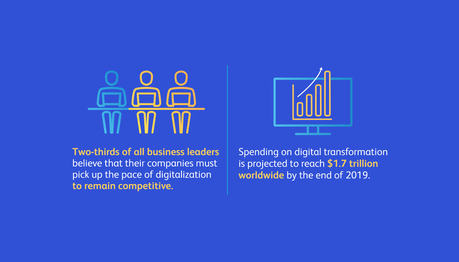Digital Workplaces Are the Future For the Legal Industry
Digital Workplaces are Answering the Demand for a Better Way to Work
June 21, 2019 at 12:10 PM
6 minute read
 Credit: Peshkova/Shutterstock.com
Credit: Peshkova/Shutterstock.com
The speed of business is accelerating. We see it happening across the legal industry as a direct result of widespread digital transformation. There is a common trend across both law firms and corporate legal departments who want to do more with the legal data that they have at their disposal in an attempt to drive faster decision making and to keep pace with the changing demands of client expectations.
The consumerization of enterprise technology has led to an increasing expectation from lawyers, clients and business users alike, that the legal technology they are using in the workplace for collaboration, knowledge management, transaction management and more should be as useful, intuitive and user-friendly as what they are already using at home on a day-to-day basis.
Digital workplaces are answering the demand for a better way to work, by providing a single platform to manage content, people and applications. As law firms review their technology strategy for the next three to five years, there is an opportunity to create digital workplaces that will match how lawyers will want to work in the future. Within a digital workplace, a lawyer will have access to relevant data and content, collaborate with both clients and colleagues, share knowledge and solve problems, all in real-time, from anywhere.
Digital transformation paves the way for digital workplaces
The impact of digital transformation is now a C-suite priority for most law firms. In fact, according to Gartner, two-thirds of all business leaders believe that their companies must pick up the pace of digitalization to remain competitive. Accordingly, spending on digital transformation is projected to reach $1.7 trillion worldwide by the end of 2019.
 Credit: HighQ
Credit: HighQThe evolution and adoption of digital trends such as big data, the shift to the cloud and the Internet of Things mean that digital transformation is no longer a novelty, it's necessity for law firms who want to win business by making it easier for their clients to interact, update and collaborate on their matters seamlessly, no matter where they're located.
We are seeing evidence of digital transformation impacting the legal industry in two ways:
1. Culture. Law firms are reviewing their operating models from human resources, business development, IT and finance to lawyers themselves. New operating models and business strategies are driving a collective cultural change that delivers more value to clients.
2. Technology. As an organization considers the cultural change they want to pursue in order to better serve their clients, they must also consider the technology stack that is required to deliver this change.
The concept of the digital workplace is born from pairing these two factors together. Businesses should be asking themselves these fundamental questions:
- What are the business goals we are trying to achieve?
- What is the cultural change required to meet those goals?
- What does the underlying technology stack need to look like to achieve those goals?
Law firms that are able to answer all of these questions will be well equipped to create a digital workplace and thrive in this digital age.
Using digital workplaces to meet client expectations
Moving toward a more digital workplace is ultimately about transforming the client experience. If we look at innovative companies such as Amazon and Netflix, they are all focused on delivering a great customer experience and have created solutions to needs that we didn't know existed. So, what can the legal industry learn from these innovative companies? It is crucial to draw insights from your data and in order to get closer to your clients. It's a well-known fact that much of the success of Netflix comes from their data-driven approach to content production. Is it such a strange idea for law firms to take a similar approach?
Transforming the client experience in legal is more than just adopting the latest technology and delivering new legal service delivery models. Designing a client-centric experience seems almost counterintuitive for an industry where the partnership model and billable hour have served so well. As law firms begin to embrace a culture of change, the challenge is to first identify exactly what the underlying client experience should be and secondly, to define which business processes need to change to meet it.
Beyond the obvious improvements for clients, by embracing these challenges and offering digital workplaces, the firm creates a much better experience for lawyers and business users as well.
Digital workplaces as an indicator of innovation
Too often we see a contradiction between what the law firm is trying to achieve culturally and the technology that they have available to them. Browse to any number of law firm websites and you will find the words 'innovation' and 'collaboration' listed as either core values or differentiators. And yet, it is still common working practice for lawyers to work in closed offices within information silos and at the same time, still have to login through a VPN before they can access the information they need on the go.
Clients are increasingly looking for meaningful differentiators between their panel firms. These days they may need to look beyond the legal pitch for evidence of true 'innovation' and 'collaboration'. Perhaps it's no longer enough to ask the question “How are you using technology to deliver my needs more efficiently” as most firms have access to the same technology and tools. Perhaps the more revealing question is “How are you using technology in your day-to-day work within the firm?” The answer to this question will help indicate whether or not the firm has really embraced digital transformation and digital workplaces to drive innovation. Law firms that only use technology to improve client-facing interactions are missing out on the opportunity to work more intelligently within their own business.
In today's competitive legal landscape, law firms have to be closer to their clients than ever, understanding their business more deeply and delivering solutions to problems that clients may not even know they have yet. At the same time, clients are expecting firms to be using data, artificial intelligence and other technologies to predict outcomes, reduce costs, improve transparency and ultimately add value. The digital workplace will be one solution a law firm can provide to meet these needs. As client demands and expectations for more digital workplaces grow, law firms can't afford to disappoint.
In his role as a client success consultant, James Lo empowers clients with the knowledge and tools to leverage HighQ and achieve their business goals. He is passionate about building relationships, improving business processes and finding new ways to help clients get the most out of their legal technology. James holds a software engineering degree and brings more than 12 years of legal experience and law firm insight to his role.
This content has been archived. It is available through our partners, LexisNexis® and Bloomberg Law.
To view this content, please continue to their sites.
Not a Lexis Subscriber?
Subscribe Now
Not a Bloomberg Law Subscriber?
Subscribe Now
NOT FOR REPRINT
© 2025 ALM Global, LLC, All Rights Reserved. Request academic re-use from www.copyright.com. All other uses, submit a request to [email protected]. For more information visit Asset & Logo Licensing.
You Might Like
View All

Nondisparagement Clauses in Divorce: Balancing Family Harmony and Free Speech
6 minute read

Trending Stories
- 1Uber Files RICO Suit Against Plaintiff-Side Firms Alleging Fraudulent Injury Claims
- 2The Law Firm Disrupted: Scrutinizing the Elephant More Than the Mouse
- 3Inherent Diminished Value Damages Unavailable to 3rd-Party Claimants, Court Says
- 4Pa. Defense Firm Sued by Client Over Ex-Eagles Player's $43.5M Med Mal Win
- 5Losses Mount at Morris Manning, but Departing Ex-Chair Stays Bullish About His Old Firm's Future
Who Got The Work
J. Brugh Lower of Gibbons has entered an appearance for industrial equipment supplier Devco Corporation in a pending trademark infringement lawsuit. The suit, accusing the defendant of selling knock-off Graco products, was filed Dec. 18 in New Jersey District Court by Rivkin Radler on behalf of Graco Inc. and Graco Minnesota. The case, assigned to U.S. District Judge Zahid N. Quraishi, is 3:24-cv-11294, Graco Inc. et al v. Devco Corporation.
Who Got The Work
Rebecca Maller-Stein and Kent A. Yalowitz of Arnold & Porter Kaye Scholer have entered their appearances for Hanaco Venture Capital and its executives, Lior Prosor and David Frankel, in a pending securities lawsuit. The action, filed on Dec. 24 in New York Southern District Court by Zell, Aron & Co. on behalf of Goldeneye Advisors, accuses the defendants of negligently and fraudulently managing the plaintiff's $1 million investment. The case, assigned to U.S. District Judge Vernon S. Broderick, is 1:24-cv-09918, Goldeneye Advisors, LLC v. Hanaco Venture Capital, Ltd. et al.
Who Got The Work
Attorneys from A&O Shearman has stepped in as defense counsel for Toronto-Dominion Bank and other defendants in a pending securities class action. The suit, filed Dec. 11 in New York Southern District Court by Bleichmar Fonti & Auld, accuses the defendants of concealing the bank's 'pervasive' deficiencies in regards to its compliance with the Bank Secrecy Act and the quality of its anti-money laundering controls. The case, assigned to U.S. District Judge Arun Subramanian, is 1:24-cv-09445, Gonzalez v. The Toronto-Dominion Bank et al.
Who Got The Work
Crown Castle International, a Pennsylvania company providing shared communications infrastructure, has turned to Luke D. Wolf of Gordon Rees Scully Mansukhani to fend off a pending breach-of-contract lawsuit. The court action, filed Nov. 25 in Michigan Eastern District Court by Hooper Hathaway PC on behalf of The Town Residences LLC, accuses Crown Castle of failing to transfer approximately $30,000 in utility payments from T-Mobile in breach of a roof-top lease and assignment agreement. The case, assigned to U.S. District Judge Susan K. Declercq, is 2:24-cv-13131, The Town Residences LLC v. T-Mobile US, Inc. et al.
Who Got The Work
Wilfred P. Coronato and Daniel M. Schwartz of McCarter & English have stepped in as defense counsel to Electrolux Home Products Inc. in a pending product liability lawsuit. The court action, filed Nov. 26 in New York Eastern District Court by Poulos Lopiccolo PC and Nagel Rice LLP on behalf of David Stern, alleges that the defendant's refrigerators’ drawers and shelving repeatedly break and fall apart within months after purchase. The case, assigned to U.S. District Judge Joan M. Azrack, is 2:24-cv-08204, Stern v. Electrolux Home Products, Inc.
Featured Firms
Law Offices of Gary Martin Hays & Associates, P.C.
(470) 294-1674
Law Offices of Mark E. Salomone
(857) 444-6468
Smith & Hassler
(713) 739-1250






